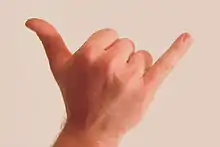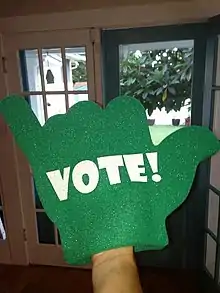Shaka sign
The shaka sign, sometimes known as "hang loose", is a gesture of friendly intent often associated with Hawaii and surf culture. It consists of extending the thumb and smallest finger while holding the three middle fingers curled, and gesturing in salutation while presenting the front or back of the hand; the hand may be rotated back and forth for emphasis. While the shaka sign has spread internationally from its Hawaiian cultural roots to surf culture and beyond, the hand gesture also bears a variety of meaning in different contexts and regions of the world.

Origins
According to the Honolulu Star-Bulletin,[1] prevailing local lore credits the gesture to Hamana Kalili of Laie,[2] who lost the three middle fingers of his right hand while working at the Kahuku Sugar Mill. Kalili was then shifted to guarding the sugar train, and his all-clear wave of thumb and pinkie is said to have evolved into the shaka as children imitated the gesture.[3][4][5][6][7][8][9][10]
Another theory relates the origin of the shaka to the Spanish immigrants, who folded their middle fingers and took their thumbs to their lips as a friendly gesture to represent sharing a drink with the natives they met in Hawaii.[11][12][13][14][15][16]
The late Lippy Espinda, a used car salesman and Oahu-based entertainer, has also been named as a possible creator of the shaka.[17][18] Espinda, who frequently appeared as an extra in Hawaii Five-O as well as The Brady Bunch episodes shot in Hawaii, used the term and the sign during his television ads in the '60s. Though the claim that he is the originator of the shaka sign is debatable, he is credited with increasing its popularity and of Hawaiian Pidgin as well.[1] The shaka has achieved great popularity in Australia, primarily among teenagers on social media sites such as Instagram and Facebook.

The word shaka is also used as an interjection expressing approval, which may predate its use for the shaka sign. According to The Oxford English Dictionary the origin of the word is uncertain, but it may come from Japanese, where it is a byname for the Buddha.[19]
Meaning and use
Residents of Hawaii use the shaka to convey the "Aloha Spirit", a concept of friendship, understanding, compassion, and solidarity among the various ethnic cultures that reside in Hawaii, lacking a direct semantic to literal translation. The shaka can also be used to express "howzit?", "thanks, eh?", and "all right!". Drivers will often use it on the road to communicate distant greetings and gratitude.
In California, the shaka sign may be referred to as "hang loose" or "hang ten", both associated with surfer culture.[20]
The gesture enjoys common use in American hang gliding culture, for both sentiment and word play, in part due to the simultaneous rise of surfing and hang gliding in California in the 1960s and 1970s. It is also widely used among triathletes, skydivers, base jumpers, wakeboarders, scuba divers, paragliders, pilots, skateboarders, and speed-flyers.
Along coastal Brazil, the shaka sign, known as the "hang loose" (also derived from an eponymous clothing brand, which uses the shaka as a logo), is a common gesture; Ronaldinho usually celebrated the goals he scored by giving the crowd a double shaka. It is also associated with the Brazilian jiu jitsu community internationally.[20]
There are several emoticon representations of the shaka sign, including \,,,/, \m/, and \,,,_. The earliest known use of the first two, with three commas or a lower case "m" corresponding to a hand's three middle fingers, is from 2006.[21] The last, similar to the first except that it represents the thumb extended horizontally (as if perpendicular to the wrist) is reported, together with the first form, from Brigham Young University in 2016.[22]
Similar gestures
Beverages
The sign can also be used to indicate the imbibing of a bottled drink, either alcoholic or non-alcoholic, as attested to below, by placing the thumb to the mouth and motioning the little finger upward as if tipping up a bottle's bottom end. A similar meaning can be achieved by pressing the thumb up against the tip of the nose with the little finger raised upwards parallel to the bridge of the nose. Referred to as "schooies" (Australian slang for a schooner)[23][24] the sign is thought to have originated in Perth.
Telecommunications

With the thumb held near the ear and the little finger pointed at the mouth, the gesture is commonly understood to mean "call me", as it resembles a hand held telephone. The Unicode 9.0 emoji 🤙 "Call me hand"[25] can be mistaken for a shaka sign.
Smoking
In Australia and Russia raising the thumb to the mouth while pointing the little finger to the air is seen as invitation for one to smoke marijuana, the posture resembling the use of a pipe. Similarly in New Zealand, this gesture symbolises smoking a "P" (methamphetamine) pipe, as well as variations of the shaka sign being the recognised gang salute for the Mongrel Mob.[26]
Notable incidents
Since 2015, fans of the Church-of-Jesus-Christ-of-Latter-Day-Saints-sponsored Brigham Young University (also known colloquially as "The Y") have started using the gesture, in deference to newly hired Kalani Sitake, BYU's Polynesian head football coach, and because of its similarity with the letter Y in the American manual alphabet that is used with American Sign Language. Perhaps most importantly there, it is used as a nod of respect to Hamana Kalili, a native Hawaiian Mormon who according to locals is the founder of the popular sign.[22]
See also
- ILY sign
- List of gestures
- List of mudras
- Manual communication
- Sign of the horns
- Thumb signal
References
- Watanabe, June (31 March 2002). "Wherever it came from, shaka sign part of Hawaii". Honolulu Star-Bulletin. Retrieved 13 January 2011.
- "Honoring the Founder of the Shaka Hamana Kalili". This Week Hawaii. 16 June 2017.
- "The Shaka". Polynesian Cultural Center. Archived from the original on 22 June 2011. Retrieved 13 January 2011.
- "The history of the famous surfing shaka sign". SurferToday.
- "Archived copy". Archived from the original on 27 August 2017. Retrieved 27 August 2017.CS1 maint: archived copy as title (link)
- Dylan Heyden (15 June 2016). "Everything You Wanted to Know About the History of the Shaka". The Inertia.
- Joe Kukura (30 July 2015). "How Four Small-Town Oahu Natives Went on to Change the World". Polynesian Cultural Center.
- A Tribute to Hamana Kalili. 28 July 2001 – via YouTube.
- Shawn Young (November 2008). "Shaka, Brah!". The Surfer's Journal. p. 135. via Shawn Young. "The Origin of the Shaka Sign".
- "Hamana Kalili, Originator of the Shaka Sign". hamanakalili.info. 24 March 2013.
- "Hawaii's shaka symbol". To-Hawaii.com. Retrieved 23 October 2013.
- Bob Krauss (25 September 2005). "Theorizing about birth of shaka". The Honolulu Advertiser.
- https://magazine.byu.edu/article/handy-way-rep-y/
- "The Origin of the "Shaka" Sign". Archived from the original on 22 February 2003.
- Sean Reavis (18 March 2016). "The Shaka- History of the Hawaiian "Hang Loose"". Boarders. Archived from the original on 25 March 2016.
- Céline Nguyen. "SURFIN' USA". Surf Library. See Appendix.
- "The Funniest People in Hawaii". Honolulu Magazine. Retrieved 26 December 2014.
- "Theorizing about birth of shaka". The Honolulu Advertiser. Retrieved 26 December 2014.
- Katherine Connor Martin, Head of US Dictionaries (December 2016). "Release notes: Bama and shaka: how two local words went global". Oxford University Press. Retrieved 8 February 2021.
- Cam (27 September 2010). "Cam in South America: Brazil and I celebrate our two-month anniversary: reflections on our relationship". Retrieved 2 July 2016.
- Geal, Alan (1 October 2006). "Aux armes · mottoes: clarere audere gaudere & ζητεῖν τὴν ἀλήθειαν". Pleiade.org. Retrieved 2 July 2016.
an innocently hedonistic call of American West Coast youth in the 1960s, Surf's up! : \,,,/ or \m/ Hang loose!
- Walker, Michael R. (Summer 2016). "World-Famous Shaka Started By Hawaiian Latter-day Saint". BYU Magazine. Retrieved 10 August 2016.
- "Schooie". Slang Dictionary. Retrieved 25 July 2016.
Australian Slang: schooner of beer
- "Definition of Schooie". Babylon. Retrieved 25 July 2016.
Australian Slang: schooner of beer
- "U+1F919: CALL ME HAND" (PDF). unicode.org.
- Newbold, Greg; Taonui, Rāwiri (12 November 2012). "Gangs – Māori gangs and Pacific youth gangs". Te Ara – The Encyclopedia of New Zealand.
| Wikimedia Commons has media related to Shaka sign. |